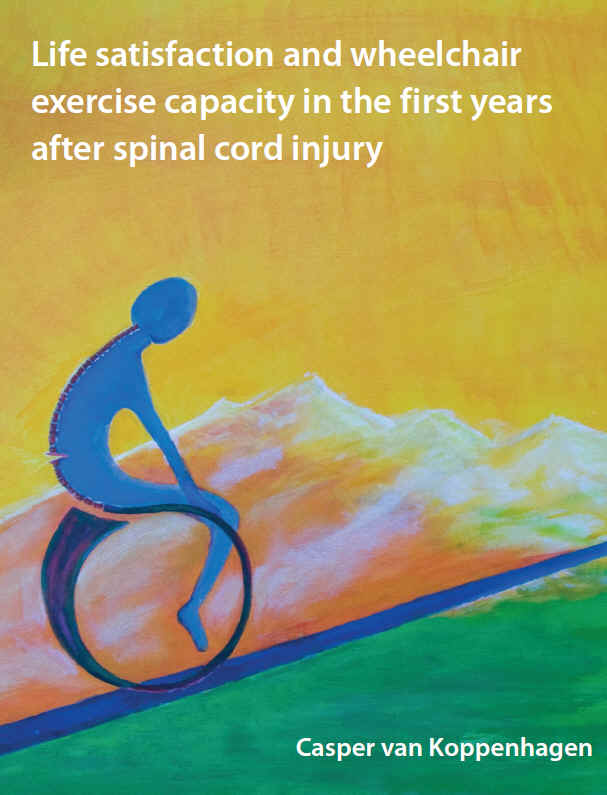Life satisfaction and wheelchair exercise capacity
in the first years after spinal cord injury
![]()
 Casper van Koppenhagen,
MD (Researcher)
Casper van Koppenhagen,
MD (Researcher)
Marcel Post, PhD (Project leader)
Lucas van der Woude, PhD
Sonja de Groot, PhD
Eline Lindeman, PhD
Floris van Asbeck, MD, PhD
On May 15, 2013 Casper van Koppenhagen will defend his dissertation entitled:
Life satisfaction and wheelchair exercise capacity in the first years after spinal cord injury.
Summary
In
Chapter 1 an overview was given of
the research context of this thesis.
The
results of Chapter 2 showed a
marked decrease in life satisfaction of persons with spinal cord injury at one
year after discharge from inpatient rehabilitation, compared to the general
population and to their own life satisfaction before spinal cord injury.
Decrease
of life satisfaction was strongest for the domains Sexual life, Self care and
Vocational situation. Partner relations, Family life and Contacts with friends
and acquaintances appeared the least affected life domains. Age,
gender and education had little influence on life satisfaction after spinal
cord injury
or change of life satisfaction. High level of lesion, suffering from pain and
from secondary impairments were associated with a decrease of life
satisfaction and with low life satisfaction one year after discharge.
The
results of
Chapter 3 showed
that life satisfaction improved during inpatient rehabilitation, especially
during the first 3 months of active rehabilitation and remained stable during
the first year after discharge. Having few pain sensations and a low number of
other secondary impairments and having a better functional status were
predictors of a more favourable course of life satisfaction early after spinal
cord injury.
Wheelchair
exercise capacity
Our
results in Chapter 4 were showed
that no significant changes in mean wheelchair exercise capacity were found
between discharge and five years later. No
significant determinants for the course of wheelchair exercise capacity in the
one to five year interval were detected. Again
age,
gender, level and completeness of lesion were determinants for peak oxygen
uptake and level of lesion and gender for peak power output, a
confirmation of other international studies.
The loss to follow up-group was older of age and included more persons with
tetraplegia, probably leading to a slight overestimation of the model outcome
for wheelchair exercise capacity.
Chapter
5 confirmed
that different wheelchair exercise capacity trajectories exist after spinal
cord injury.. We found four different trajectories in the course of peak power
output: 1) high progressive scores; 2) deteriorating scores: progressive
scores during inpatient rehabilitation with deteriorating figures after
discharge; 3) low progressive scores: low
scores at start of rehabilitation with relative strong progressive scores
after discharge; and 4) low
inpatient scores with very strong progressive scores after discharge. Logistic
regression of factors that might be distinctive between the trajectories with
high progressive scores and low progressive scores, revealed that older age, female
gender, tetraplegic lesion and low functional status were associated with the
class with low progressive scores.
Relationships
between wheelchair exercise capacity
and life satisfaction
In
Chapter 6 we examined that
wheelchair exercise capacity and life satisfaction in spinal cord injury
population are longitudinally associated up to five years after discharge of
inpatient rehabilitation. Further analyses revealed that the relationship
between exercise capacity and life satisfaction was mainly based on the
within-subject variance, suggesting that improvement of physical fitness might
lead to improvement of life satisfaction
Finally,
Chapter
7
summarized the general aim and main findings of this study.
You can read more about this project in the Dutch newsletters
of April
2009, November
2009, May
2010, November
2010, and August
2011 or in the Dutch report
for the participants of SPIQUE.
Casper van Koppenhagen won the prestigious LIVIT Orthtopedics trophy 'Most promising rehabilitation trainee 2009 in the Netherlands'
for his research work in the SPIQUE Project.
Publications from this thesis
-
Determinants and changes of life satisfaction after spinal cord injury: a cohort study. Van Koppenhagen CF, Post MWM, Van der Woude LHV, de Witte LP, van Asbeck FW, de Groot S, van den Heuvel W, Lindeman E. Arch Phys Med Rehab 89(9): 1733-40, 2008.
-
Recovery of life statisfaction in persons with spinal cord injury during inpatient rehabilitation. Van Koppenhagen CF, Post MWM, Van der Woude LHV, de Groot S, de Witte LP, van Asbeck FW, van den Heuvel W, Lindeman E. Am J Phys Med Rehab. 2009; 88(11): 887-95.
-
Wheelchair exercise capacity in spinal cord injury up to 5 years after discharge of inpatient rehabilitation. Van Koppenhagen CF, de Groot S, Post MW, van Asbeck FW, Spijkerman D, Faber W, Lindeman E, van der Woude LH. J Rehabil Med. 2013; 45(7):646-52.
-
Patterns of changes in wheelchair exercise capacity after spinal cord injury. Van Koppenhagen CF, de Groot S, Post MW, Hoekstra T, van Asbeck FW, Bongers W, Lindeman E, van der Woude LH. Arch Phys Med Rehabil. 2013; 94(7):1260-7.
-
The longitudinal relationship between wheelchair exercise capacity and life satisfaction after spinal cord injury: a cohort study in the Netherlands. Van Koppenhagen CF, de Groot S, Post MW, van Leeuwen C, van Asbeck FW, Stolwijk J, van der Woude LH. J Spinal Cord Med. 2014; 37(3):328-37.
|
|
|
 |